Reishi mushrooms, a.k.a. Lingzhi, have been used for centuries in traditional Chinese medicine for their health benefits.
They contain various compounds with anti-inflammatory, immune-boosting, and anti-cancer properties. To fully enjoy the benefits of reishi mushrooms, it’s essential to dry them properly.
Well, do you know how to dry reishi mushrooms in the easiest manner? Don’t worry, even if you don’t.
Because, in this article, we’ll explore the importance of proper drying techniques for reishi mushrooms and provide practical tips for sun-drying, oven-drying, and using a dehydrator.
We’ll also go through some traditional recipes so that you can make use of this powerful natural healer. Let’s dive in, shall we?
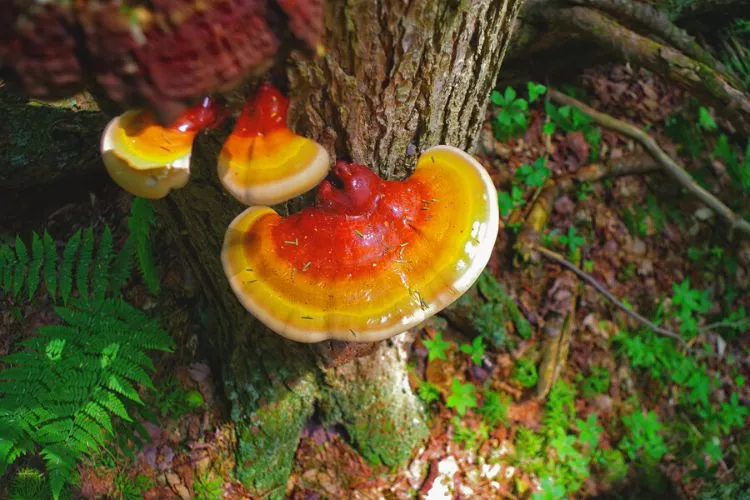
Table of Contents
What Do Reishi Mushrooms Look Like?
Reishi mushrooms are easy to identify due to their unique appearance. They have a distinctive shape consisting of a flat, kidney-shaped cap and a short, stout stem slightly off-center.
The cap is usually reddish-brown or dark brown. It has a glossy and slightly varnished surface that may crack over time.
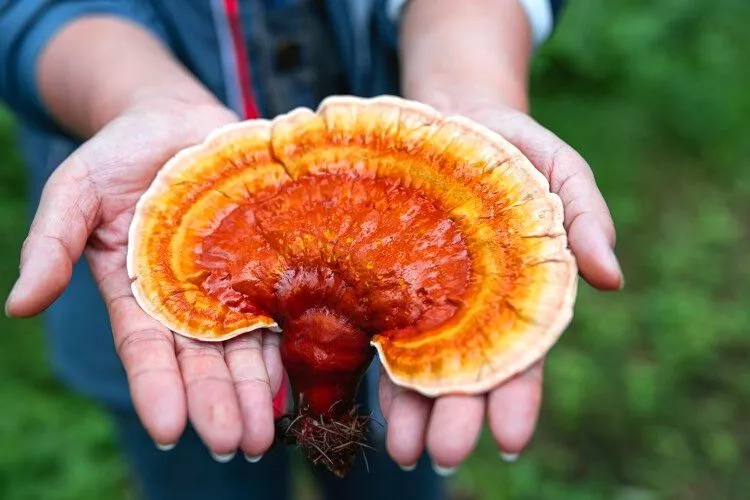
The underside of the cap has a series of tiny, closely spaced pores instead of gills. Reishi mushrooms are usually found growing on decaying logs, stumps, or tree roots and are known to grow up to 8 inches in diameter. Their appearance may vary slightly depending on the specific species and growing conditions.
How to Dry Reishi Mushrooms? (3 easy Techniques)
Three main techniques for drying reishi mushrooms are sun drying, oven drying, and using a dehydrator. Each method has its benefits and drawbacks, so choosing the one that best fits your needs and resources is important. Here’s a closer look at each method:
Sun Drying
Sun drying is probably the most traditional and energy-efficient method for drying reishi mushrooms. This method has been used for centuries. It requires optimal weather conditions and may take several days to complete.
However, it is the most natural way to dry mushrooms and can help to enhance their flavor. Here are the simple steps for sun-drying reishi mushrooms:
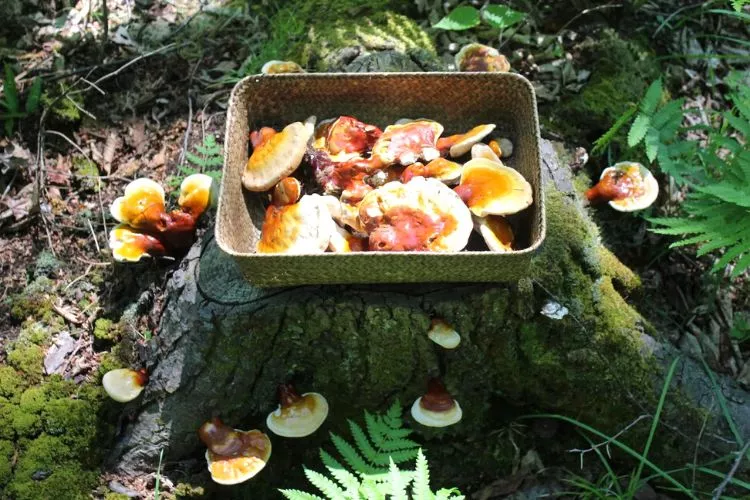
- Find a sunny and dry location with good air circulation. This may include a porch, balcony, or roof.
- Slice the mushrooms thinly and evenly to ensure uniform drying.
- Place the mushroom slices on a wire mesh or a clean, dry cloth.
- Cover them with a light cloth to protect them from insects and dust, but not too tightly, as it can trap moisture and ruin the process.
- Place the tray or cloth under direct sunlight and occasionally turn the mushrooms over to ensure they dry evenly.
- Check them regularly for any signs of mold or spoilage. Discard any that are this way, as they are unusable.
- Transfer them to an airtight container for storage when they are completely dry and crisp. This process can take anywhere up to several days.
Pro tips for sun drying
The main thing to remember is to avoid drying mushrooms during humid or rainy weather. These conditions will prolong the drying time and increase the risk of spoilage.
One cool tip we learned through trial and error is adding a pinch of salt or spices to the mushrooms before drying to enhance their flavor.
Oven Drying
Oven drying is a faster and more reliable method for drying reishi mushrooms that can be done at home with a standard oven. This method requires careful temperature control and ventilation to prevent over-drying or burning. Here are the steps for oven-drying reishi mushrooms:
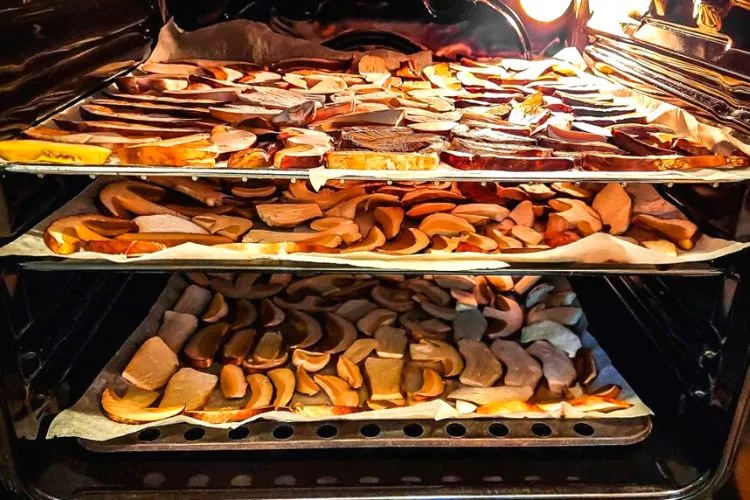
- Preheat the oven to 140°F (60°C) or the lowest possible temperature setting.
- Slice the mushrooms thinly and evenly, and arrange them on a baking sheet or a wire rack.
- Place the sheet or rack in the oven and leave the oven door slightly ajar to ensure good ventilation. (This last part is key)
- Check the mushrooms regularly and rotate the tray or rack to ensure they dry evenly.
- When the mushrooms are dehydrated and crisp, remove them from the oven and let them cool.
- Transfer the dried mushrooms to an airtight container for storage and eventual usage.
Pro tips for oven drying
Use a thermometer to check the oven temperature and adjust it as needed. This will save you a ton of time and effort. You can also use a fan or a dehumidifier to speed up the drying process and reduce the risk of moisture buildup.
Using a Dehydrator
Dehydrators are a convenient and efficient method for drying reishi mushrooms, and they require minimal effort and time. This method ensures even and consistent drying but requires the initial investment of a dehydrator.
However, it’s a win-win if you use them often and have one already. Here are the steps for using a dehydrator to dry reishi mushrooms:
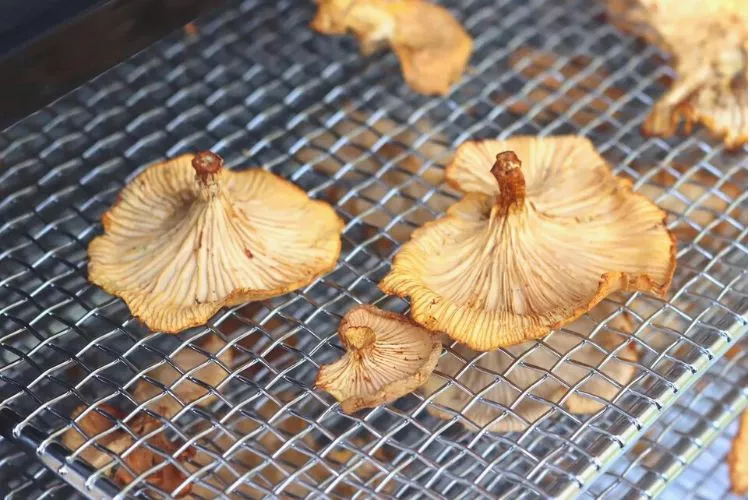
- Slice the mushrooms thinly and evenly, and arrange them on the dehydrator trays.
- Set the dehydrator to 140°F (60°C) or the recommended drying temperature for mushroom drying.
- Let the dehydrator run for several hours, check the mushrooms regularly for any signs of over-drying or under-drying, and adjust accordingly.
- When the mushrooms are completely dry and crisp, remove them from the dehydrator and cool them.
- Transfer the dried mushrooms to an airtight container for storage.
Pro tips for Using a Dehydrator
Follow the instructions for your specific dehydrator and adjust the settings as needed. You can speed up the drying process by slicing the mushrooms a little bit thinner but ensure they are even and have good air circulation. You can also use the dehydrator to dry other herbs, fruits, or vegetables simultaneously to save energy and time.
Avoid drying strong-smelling foods like garlic or onions simultaneously with mushrooms, as they can absorb their aroma. Finally, label the dried mushrooms with the drying date and use them within a year for the best quality and flavor.
Storing Dried Reishi Mushrooms
Once you’ve dried your reishi mushrooms, it’s important to store them properly to ensure they last longer and stay potent. Here are some tips on how to store dried reishi mushrooms:
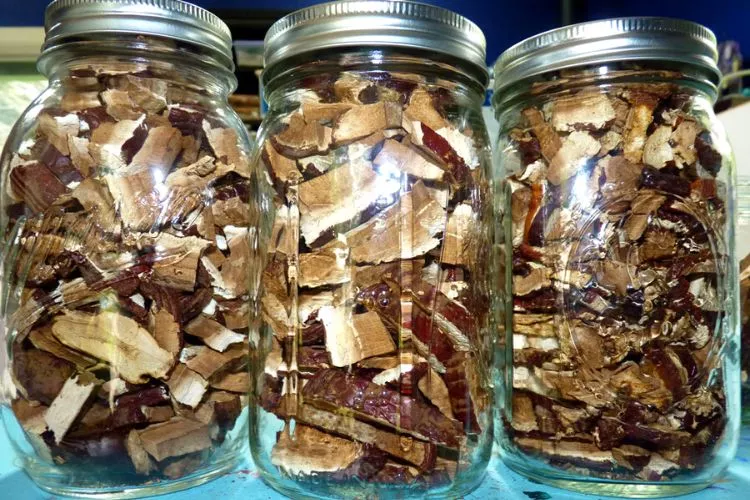
Proper Storage Containers
Dried reishi mushrooms should be stored in airtight containers to prevent moisture, heat, or light from getting in and spoiling them. Glass jars, plastic bags, or vacuum-sealed bags are the best options for storage.
Ensure that whatever containers you use are clean and dry before adding the mushrooms. This will help avoid overpacking or crushing them, preventing them from breaking or absorbing moisture.
Recommended Storage Locations
The best location to store dried reishi mushrooms is in a cool, dry, and dark place free from direct sunlight, heat, or moisture. A pantry, cupboard, or basement is a good option for storage as long as the temperature is below 70°F (21°C) and the humidity is below 60%.
Avoid storing the mushrooms near strong-smelling or volatile foods, as they can affect their flavor. Store them like any dried herb you don’t want spoiled.
Shelf Life of Dried Mushrooms
The shelf life of dried reishi mushrooms depends on several factors. They include the drying method, the storage conditions, and the initial quality of the mushrooms. On average, dried reishi mushrooms can last up to 1 year when stored properly.
However, their flavor, aroma, and nutritional value can decline over time, so it’s a good idea to use them within 6 months of preparing them for the best quality.
To extend their shelf life, try storing them in the freezer or add a desiccant packet to the storage container to absorb any excess moisture.
Using Dried Reishi Mushrooms
Dried reishi mushrooms are versatile and flavorful ingredients that can be used in various dishes and drinks. Here are some tips on how to use dried reishi mushrooms:
Rehydrating Dried Mushrooms
Before using dried reishi mushrooms in recipes, it’s important to rehydrate them to restore their texture and flavor. Here’s how to rehydrate dried reishi mushrooms:
- Place your desired amount of dried reishi mushrooms in a bowl or container.
- Add enough warm water to cover the mushrooms completely, and let them soak for 20-30 minutes.
- Drain them out and gently squeeze them to remove any excess water.
- The rehydrated mushrooms are now ready to use in recipes.
Cooking with Dried Mushrooms
Dried reishi mushrooms can add a unique umami flavor, texture, and nutritional value to many dishes. The taste suits cuisines that utilize stir-fries, soups, stews, risottos, omelets, and teas. Here are some tips for cooking with dried reishi mushrooms:
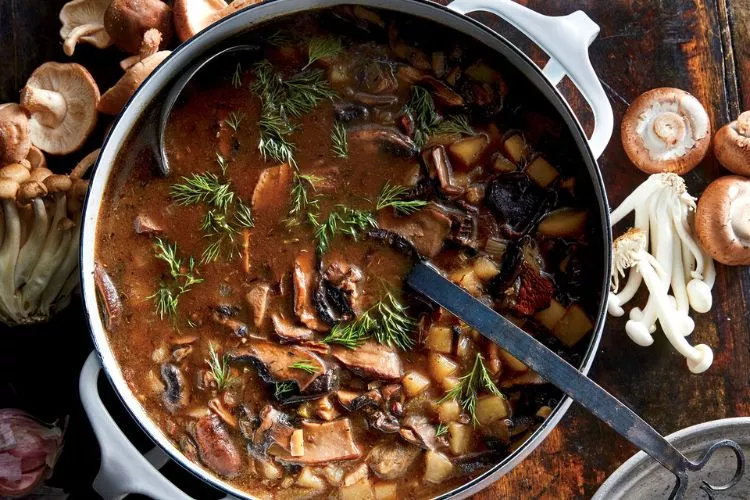
- Slice or chop the rehydrated mushrooms to the desired size and shape.
- Add the mushrooms to the recipe during cooking, or soak them in hot water for a stronger flavor and aroma.
- Adjust the seasoning and cooking time to complement the mushrooms’ flavor and texture.
- Combine dried reishi mushrooms with other dried mushrooms, herbs, or spices to create a more complex and rich flavor.
- Experiment a little; you’ll be surprised at how tasty these mushrooms can be, especially in stir-fries, soups, and stews.
Dried Reishi Mushroom Tea
Dried reishi mushroom tea is a popular and healthy drink that can be enjoyed on its own or mixed with other herbs or spices. Here’s a recipe for making dried reishi mushroom tea:
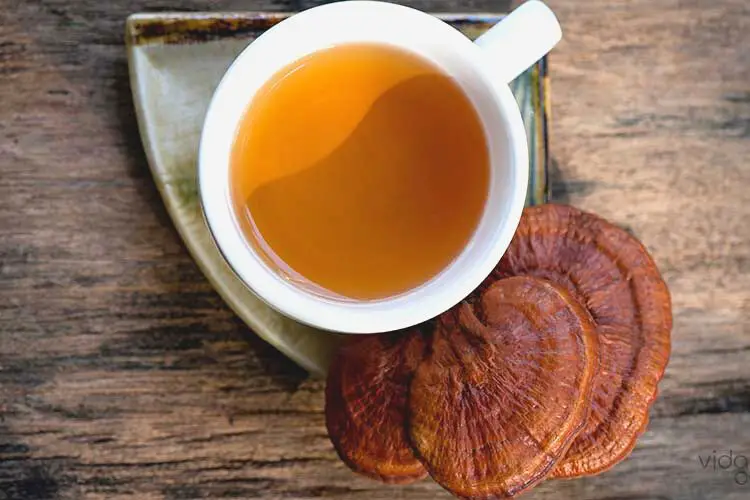
Ingredients:
- 2-3 dried reishi mushroom slices
- 4 cups of water
- Optional: honey, lemon, ginger, or cinnamon for taste
Directions:
- Bring the water to a boil in a pot or kettle.
- Add the dried reishi mushroom slices to the water and reduce the heat to low.
- Simmer the mushrooms for 30-45 minutes or until the water turns dark brown and fragrant.
- Strain the tea using a fine mesh strainer or a cheesecloth.
- If desired, add honey, lemon, ginger, or cinnamon to taste.
- Serve the tea hot or cold, and enjoy its health benefits.
Health Benefits of Drinking Reishi Mushroom Tea
Reishi mushroom tea is known for its numerous health benefits, such as boosting the immune system, reducing inflammation, and improving sleep quality. Reishi mushrooms are rich in polysaccharides, triterpenes, and antioxidants, which can support overall health and well-being.
Drinking reishi mushroom tea regularly can also help to reduce stress, anxiety, and fatigue and enhance cognitive function and mood.
Dried Reishi Mushroom Recipe
Dried reishi mushrooms can be used in various recipes to add a unique and savory flavor. Here’s a recipe for using dried reishi mushrooms in cooking:

Ingredients:
- 1 cup of dried reishi mushroom slices
- 2 tablespoons of vegetable oil
- 1 onion, chopped
- 3 garlic cloves, minced
- 1 tablespoon of soy sauce
- 1 tablespoon of oyster sauce
- 1 tablespoon of cornstarch
- 1 cup of vegetable broth
- Salt and pepper to taste
Directions:
- Rehydrate the dried reishi mushroom slices following the previous section’s steps.
- Heat the vegetable oil in a pan over medium heat.
- Add the chopped onion and minced garlic, and sauté for 2-3 minutes.
- Add the rehydrated reishi mushroom slices to the pan and stir-fry for another 3-5 minutes or until they are tender and slightly crispy.
- Whisk together the soy sauce, oyster sauce, cornstarch, and vegetable broth in a separate bowl until smooth.
- Pour the sauce over the mushroom mixture and stir to coat evenly.
- Cook the mixture for another 2-3 minutes until the sauce thickens and bubbles.
- Season with salt and pepper to taste.
- Serve the dish hot with rice or noodles or as a side dish to meat or vegetables.
- You can also garnish the dish with fresh herbs or sesame seeds for extra flavor and texture.
Reishi Mushroom Health Benefits
Reishi mushrooms have been used for centuries in traditional Chinese medicine for their numerous health benefits.
Some of these ancient cultures are known to have elders that live for well over 100 years using these types of natural herbs and foods to prolong their lives.
Therefore, the principals must hold some depth and value. Here’s an overview of the health benefits of reishi mushrooms:
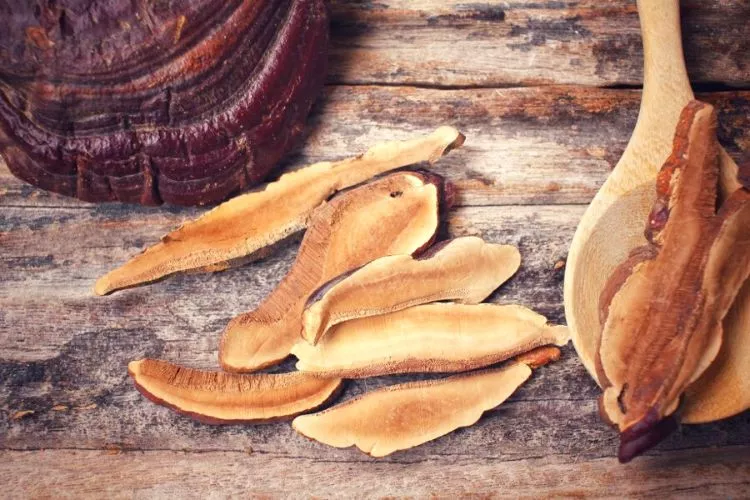
- Boosting the immune system: Reishi mushrooms contain beta-glucans, which can stimulate the immune system and improve its response to infections, viruses, and cancer cells.
- Reducing inflammation: Reishi mushrooms have anti-inflammatory properties that can help to reduce pain, swelling, and redness in the body, particularly in people with arthritis or asthma. Once inflammation can be controlled, other body parts and functions can be worked on to heal as part of a holistic approach.
- Improving heart health: Reishi mushrooms can lower blood pressure, cholesterol, and triglyceride levels. This helps to reduce the risk of heart disease, stroke, and other cardiovascular conditions.
- Fighting cancer: Reishi mushrooms contain triterpenes, which are known to inhibit the growth and spread of cancer cells and assist in the healing of the ailment.
While many of these health benefits are supported by scientific research, more studies are needed to confirm their effectiveness and safety. As with any dietary supplement or natural remedy, it’s important to consult a healthcare provider before using reishi mushrooms for medicinal purposes.
Reishi Mushroom Potential Side-Effects
While reishi mushrooms are generally considered safe for most people, they can also cause some side effects in certain cases. Here’s a list of potential side effects of reishi mushrooms:
- Allergic reactions: Some people may be allergic to reishi mushrooms, which can cause symptoms such as itching, hives, swelling, or difficulty breathing.
- Stomach upset: Reishi mushrooms can cause digestive problems, such as nausea, diarrhea, or constipation, particularly in high doses or sensitive individuals.
- Blood thinning: Reishi mushrooms can act as a natural blood thinner, increasing the risk of bleeding or bruising in people taking blood-thinning medications or with bleeding disorders.
- Low blood pressure: Reishi mushrooms can lower blood pressure, which can cause dizziness, lightheadedness, or fainting in people with low blood pressure or on blood pressure-lowering drugs.
To minimize the risk of side effects, following the recommended dosage and duration of reishi mushroom use is important. Furthermore, you should always consult a healthcare provider before using them for medicinal purposes, particularly if you have any medical conditions or are taking any medications.
Frequently Asked Questions (FAQs)
Can Reishi Mushrooms Cure Cancer?
While reishi mushrooms contain compounds that may have anti-cancer properties, there is currently no scientific evidence to support the claim that they can cure cancer. More research is needed to understand their potential benefits and risks in cancer prevention and treatment.
How long does dried Reishi last?
When stored properly in an airtight container in a cool, dry, and dark place, dried Reishi mushrooms can last up to 2 years or more. However, their quality and potency may decline over time, so it’s best to use them within 1 year for optimal results.
What is the best mushroom for anti-aging?
Reishi mushrooms are often considered the best for anti-aging due to their high levels of antioxidants, anti-inflammatory compounds, and immune-boosting properties. They may even help to reduce the signs of aging. These include symptoms such as wrinkles, age spots, and reduced skin elasticity. The shrooms protect the skin from oxidative stress and support collagen production.
Conclusion:
Properly drying reishi mushrooms is crucial for preserving their quality, flavor, and health benefits. Whether you choose to sun dry, oven dry, or use a dehydrator, following the right techniques and tips can help you achieve the best results.
Reishi mushrooms are packed with nutrients and medicinal properties that can improve your immune system, heart health, and skin quality, among other benefits.
You can enjoy their unique flavor and health benefits year-round by incorporating dried reishi mushrooms into your diet and lifestyle.
We hope that this guide on how to dry reishi mushrooms has been helpful. You can read about similar topics here on our website. Check back again soon for more.


